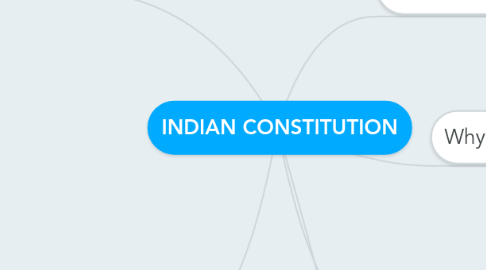INDIAN CONSTITUTION
von shital gunjal


1. Republic Day
1.1. On 26 January 1950, the Constitution of India was adopted. The 'Constitution' replaced the 'Government of India Act(1935)' as the governing document of India. That is why we celebrate Jan 26 every year as our Republic Day. 26 January was selected because it was on this day in 1930 when the Declaration of Indian Independence (Purna Swaraj) was proclaimed.
2. A working document. Not STATIC
2.1. Amendments
2.1.1. Procedure
2.1.1.1. Simple Majority
2.1.1.2. Special Majority
2.1.1.2.1. 2/3rds Majority
2.1.1.2.2. Ratification by States
2.1.2. Past amendments
2.1.3. Constitution Review Commission
3. The Constitution
3.1. Preamble
3.2. Main features
3.2.1. Federalism
3.2.2. Parliamentary form of Government
3.2.3. Fundamental Rights
3.2.4. Separation of powers
3.2.5. Secularism
3.3. Directive Principles
3.3.1. Meaning
3.3.2. Fundamental Rights & Directive Principles
3.3.3. Effects & Programmes
4. Authority of the constitution
4.1. Mode of Framing
4.2. Substantive Provisions
4.3. Balanced Institutional Design
4.4. Principle of Deliberation
4.5. Inheritance of Nationalist struggle
5. Did you know
5.1. UK's constitution is not a single written document.
5.2. In Switzerland, people can directly participate in amending their Constitution
5.3. The Constitution of India has had 99 amendments since it was written in 1950 making it the most amended Constitution in the world
5.4. While all democratic countries probably have a Constitution, it is not necessary that all countries that have a Constitution are democratic.
6. What is a constitution?
6.1. A Constitution helps serve as a set of rules and principles that all persons in a country can agree upon as the basis of the way in which they want the country to be governed. This includes not only the type of government but also the ideals that they believe the country should follow.
7. Why do we need a constitution?
7.1. Set of basic rules
7.2. Type of government
7.3. Limits the powers of government
7.4. Aspirations of society
7.5. Fundamental Identity
8. The making
8.1. Background
8.2. Constituent Assembly
8.2.1. Composition
8.2.2. Leadership & Committees
